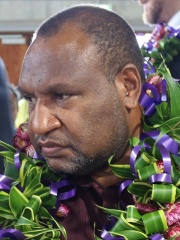
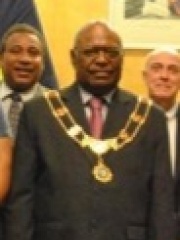
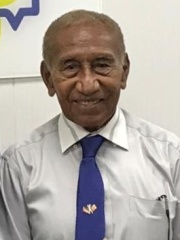
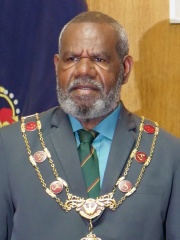
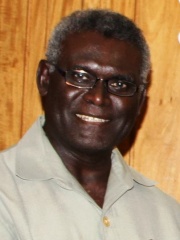
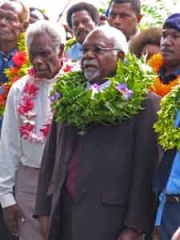
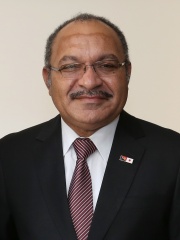
The Most Famous
POLITICIANS from Papua New Guinea
This page contains a list of the greatest Papua New Guinean Politicians. The pantheon dataset contains 19,576 Politicians, 8 of which were born in Papua New Guinea. This makes Papua New Guinea the birth place of the 176th most number of Politicians behind Dominica, and Andorra.
Top 8
The following people are considered by Pantheon to be the most legendary Papua New Guinean Politicians of all time. This list of famous Papua New Guinean Politicians is sorted by HPI (Historical Popularity Index), a metric that aggregates information on a biography's online popularity.

1. James Marape (b. 1971)
With an HPI of 62.30, James Marape is the most famous Papua New Guinean Politician. His biography has been translated into 34 different languages on wikipedia.
James Marape (born 24 April 1971) is a Papua New Guinean politician who has served as the prime minister of Papua New Guinea since May 2019. He has been a member of the National Parliament of Papua New Guinea since July 2007, representing the electorate of Tari-Pori Open in Hela Province in the New Guinea Highlands. He has held Cabinet Posts as Minister of Education (2008–2011), Minister of Finance (2012–2019), and Minister of Foreign Affairs (2023–2024). Marape entered the 2022 elections under the banner of the Pangu Party and won the most seats, while still being far from a majority. He was therefore able to form government, which was elected unopposed by the new parliament.

2. Michael Ogio (1942 - 2017)
With an HPI of 56.50, Michael Ogio is the 2nd most famous Papua New Guinean Politician. His biography has been translated into 23 different languages.
Sir Michael Ogio (7 July 1942 – 18 February 2017) was a Papua New Guinean politician who served as the ninth governor-general of Papua New Guinea from 2011 until his death in 2017. He was a member of the People's Democratic Movement party.

3. Julius Chan (1939 - 2025)
With an HPI of 56.20, Julius Chan is the 3rd most famous Papua New Guinean Politician. His biography has been translated into 22 different languages.
Sir Julius Chan (29 August 1939 – 30 January 2025) was a Papua New Guinean politician who served as Prime Minister of Papua New Guinea from 1980 to 1982 and from 1994 to 1997. He was Member of Parliament for New Ireland Province, having won the seat in the 2007 national election. He was also the Governor of New Ireland Province from 2007 until his death in 2025. On 26 May 2019, Prime Minister Peter O'Neill announced he would soon resign and that he wished for Sir Julius to succeed him. An outgoing Prime Minister does not, however, have the power to appoint his successor, and the following day O'Neill delayed his own formal resignation. He was also a leading figure in his country during the years-long Bougainville conflict.

4. Bob Dadae (b. 1961)
With an HPI of 55.59, Bob Dadae is the 4th most famous Papua New Guinean Politician. His biography has been translated into 18 different languages.
Sir Bob Bofeng Dadae (born 8 March 1961) is a Papua New Guinean politician currently serving as the tenth governor-general of Papua New Guinea since 2017.
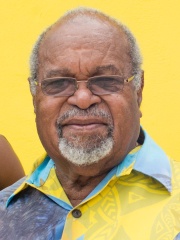
5. Michael Somare (1936 - 2021)
With an HPI of 55.58, Michael Somare is the 5th most famous Papua New Guinean Politician. His biography has been translated into 40 different languages.
Sir Michael Thomas Somare (9 April 1936 – 25 February 2021) was a Papua New Guinean politician. Widely called the "father of the nation" (Tok Pisin: Papa blo kantri), he was the first Prime Minister after independence. At the time of his death, Somare was also the longest-serving prime minister, having been in office for 17 years over three separate terms: from 1975 to 1980; from 1982 to 1985; and from 2002 to 2011. His political career spanned from 1968 until his retirement in 2017. Besides serving as PM, he was minister of foreign affairs, leader of the opposition and governor of East Sepik Province. He served in a variety of positions. His base was not primarily in political parties but in East Sepik Province, the area that elected him. During his political career he was a member of the House of Assembly and after independence in 1975 the National parliament for the East Sepik Provincial – later open – seat. He was the first chief minister at the end of colonial rule. Thereafter he became the first Prime Minister after independence from 1975 to 1980. He returned to the office of Prime Minister from 1982 to 1985, and his longest stint in the position was from 2002 to 2011. He also served as Cabinet Minister: he was minister of foreign affairs from 1988 to 1992; from 1999 to 2001 he was subsequently minister of foreign affairs, minister of mining and Bougainville, minister of foreign affairs and Bougainville affairs. He was leader of the opposition from 1968 to 1972, from 1980 to 1982, and thereafter in that position from 1985 to 1988, from 1992 to 1993, and finally from 2001 to 2002. When the new position of political governor as head of the provincial administration and representative MP was created in 1995, Somare took up the job. He was governor of East Sepik from 1995 until 1999. After the last election that he contended, he again became Governor of East Sepik (2012–2016). He was a founding member of the Pangu Party which led PNG into independence in 1975. He resigned from the Pangu Party and became an independent in 1988. He rejoined the Pangu Party in 1994 but was sacked as a leader in the following year. He was then asked to join and lead the National Alliance Party. In 2017 he left politics and also the National Alliance Party. While Somare was in March 2011 hospitalised in Singapore, a majority of parliamentarians declared the post of Prime Minister vacant. Peter O'Neill was the new prime minister. This was contested. On 12 December 2011, the Supreme Court of Papua New Guinea ordered that Somare be reinstated as Prime Minister, ruling that O'Neill had not been lawfully appointed. This event triggered the 2011–12 Papua New Guinean constitutional crisis. Following a decisive victory for O'Neill in the 2012 general election, Somare expressed support for him, thereby ending the crisis and forming a coalition government. However, this truce did not last. When Somare announced his departure from politics, he made a blistering attack on O'Neill.

6. Manasseh Sogavare (b. 1955)
With an HPI of 55.32, Manasseh Sogavare is the 6th most famous Papua New Guinean Politician. His biography has been translated into 28 different languages.
Manasseh Damukana Sogavare (born 17 January 1955) is a Solomon Islander politician who served as prime minister of Solomon Islands for a total of nine years from 2000–2001, 2006–2007, 2014–2017, and 2019–2024. Sogavare has served in the National Parliament representing East Choiseul since 1997. He also served as minister of finance from 1997–1998, 2017–2019, and 2024–2025. Sogavare has been widely accused of promoting democratic backsliding in the Solomon Islands. The Solomon Islands under Sogavare has been criticised by many as being increasingly autocratic or even authoritarian. Despite earning a modest formal salary, he has accrued a vast real estate portfolio, raising questions about his sources of income.

7. Paulias Matane (1931 - 2021)
With an HPI of 51.10, Paulias Matane is the 7th most famous Papua New Guinean Politician. His biography has been translated into 21 different languages.
Sir Paulias Nguna Matane (21 September 1931 – 12 December 2021) was a Papua New Guinean politician who served as the eighth Governor-General of Papua New Guinea from 29 June 2004 to 13 December 2010. His memoir My Childhood in New Guinea has been on the school curriculum since the 1970s. He was a long-time contributor and columnist for The National.

8. Peter O'Neill (b. 1965)
With an HPI of 49.53, Peter O'Neill is the 8th most famous Papua New Guinean Politician. His biography has been translated into 34 different languages.
Peter Charles Paire O'Neill (born 13 February 1965) is a Papua New Guinean politician who served as the seventh Prime Minister of Papua New Guinea from 2011 to 2019. He has been a Member of Parliament for Ialibu-Pangia since 2002. He was a former cabinet minister and the leader of the People's National Congress between 2006 and 2022. He resigned his position as prime minister to avoid a vote of no confidence, and he was succeeded by James Marape.
People
Pantheon has 8 people classified as Papua New Guinean politicians born between 1931 and 1971. Of these 8, 4 (50.00%) of them are still alive today. The most famous living Papua New Guinean politicians include James Marape, Bob Dadae, and Manasseh Sogavare. The most famous deceased Papua New Guinean politicians include Michael Ogio, Julius Chan, and Michael Somare.
Living Papua New Guinean Politicians
Go to all RankingsJames Marape
1971 - Present
HPI: 62.30
Bob Dadae
1961 - Present
HPI: 55.59
Manasseh Sogavare
1955 - Present
HPI: 55.32
Peter O'Neill
1965 - Present
HPI: 49.53
Deceased Papua New Guinean Politicians
Go to all RankingsMichael Ogio
1942 - 2017
HPI: 56.50
Julius Chan
1939 - 2025
HPI: 56.20
Michael Somare
1936 - 2021
HPI: 55.58
Paulias Matane
1931 - 2021
HPI: 51.10
Overlapping Lives
Which Politicians were alive at the same time? This visualization shows the lifespans of the 3 most globally memorable Politicians since 1700.

